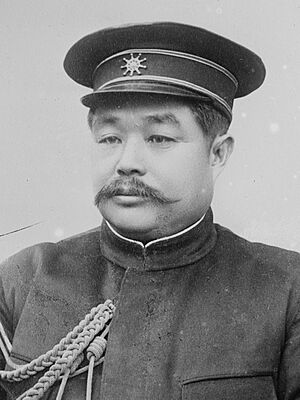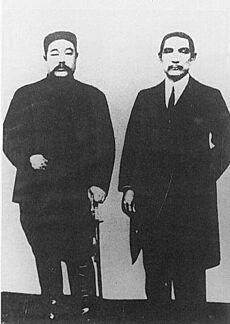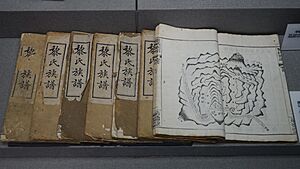Li Yuanhong facts for kids
Quick facts for kids
Li Yuanhong
|
|
|---|---|
|
黎元洪
|
|

Li c. 1915
|
|
| President of the Republic of China | |
| In office 11 June 1922 – 13 June 1923 |
|
| Preceded by | Zhou Ziqi |
| Succeeded by | Gao Lingwei |
| In office 7 June 1916 – 17 July 1917 |
|
| Preceded by | Yuan Shikai |
| Succeeded by | Feng Guozhang |
| Provisional Vice President of the Republic of China | |
| In office 1 January 1912 – 6 June 1916 |
|
| President | Sun Yat-sen Yuan Shikai |
| Succeeded by | Feng Guozhang |
| Personal details | |
| Born | 19 October 1864 Huangpi, Hubei, Great Qing |
| Died | 3 June 1928 (aged 63) Tianjin, Zhili, Republic of China |
| Political party | Republican Party Progressive Party |
| Awards | Order of Rank and Merit Order of Wen-Hu Order of the Golden Grain |
| Military service | |
| Allegiance | 1889–1911 1911–1912 |
| Branch/service | Beiyang Navy Hubei Provincial Army Tongmenghui (1911) |
| Battles/wars | First Sino-Japanese War Xinhai Revolution |
Li Yuanhong (Chinese: 黎元洪; pinyin: Lí Yuánhóng) (October 19, 1864 – June 3, 1928) was an important Chinese politician. He lived during the end of the Qing dynasty and the early years of the Republic of China. He served as the first Vice President of China from 1912 to 1916. He was also the President of the Republic of China two times: from 1916 to 1917, and again from 1922 to 1923.
Contents
Early Life and Military Career
Li Yuanhong was born in Huangpi, Hubei province. His father was a soldier who fought in the Taiping Rebellion, a major war in China. Li graduated from the naval academy in Tianjin in 1889. He then worked as an engineer in the navy.
During the First Sino-Japanese War, his ship was sunk. Li survived because he wore a life belt, as he could not swim. Later, he joined the Hubei New Army and became a high-ranking officer. In 1910, he tried to stop revolutionary groups from joining his army unit. Instead of arresting them, he simply let them go.
Becoming a National Leader

In 1911, the Xinhai Revolution began, aiming to overthrow the Qing dynasty. The rebels in Wuchang needed a well-known officer to lead them. Li Yuanhong was respected and knew English, which was helpful for dealing with foreign countries. He was reportedly found hiding and forced to become the temporary military governor of Hubei.
Even though he was reluctant at first, Li soon supported the revolution. On November 30, he was named military governor of China. The Qing government's leader, Yuan Shikai, then made a peace agreement with him.
When the Republic of China was formed, Sun Yat-sen became the first temporary president in Nanjing. Li was made vice president as a compromise. This helped unite northern and southern China and ended the Qing dynasty. Li later joined the Republican Party.
In 1913, Li helped form the Progressive Party. This party became a main rival to Sun Yat-sen's Nationalists. Li supported Yuan Shikai during a conflict known as the Second Revolution. This made his former revolutionary friends upset with him.
Yuan Shikai became very powerful and kept Li in Beijing. Li was still vice president, but he had no real power. Yuan did not fully trust Li because Li was not part of Yuan's close military group. To make their ties stronger, Yuan's son married Li's daughter. When Yuan tried to make himself emperor in 1916, some people wanted Li to become president. Li refused because he feared for his life. However, he also turned down a royal title from Yuan, which helped his reputation later. Li stayed out of public view until Yuan died.
Presidency and Later Life
Li Yuanhong served as president from June 7, 1916, to July 17, 1917. When Yuan Shikai died, he named Li as one of his possible successors. The military leaders pushed Li to become president because he was accepted by the southern provinces that had rebelled. Li tried to bring back the original 1912 constitution, but Premier Duan Qirui held the real power.
Li and Duan disagreed about China joining World War I. Li was hesitant, but Duan wanted to cut ties with Germany. Li forced Duan to resign in May 1917 when Duan's secret loans from Japan were revealed. Most generals then left the government. Li asked General Zhang Xun for help. In return, Zhang asked Li to dissolve the parliament, which Li did.
Zhang Xun then surprised everyone by trying to bring back the Qing dynasty and Emperor Puyi on July 1. Zhang occupied Beijing and held Li prisoner. Li was released and asked Duan Qirui for help to save the republic. Duan quickly overthrew Zhang and restored the republic. Li resigned from office and moved to Tianjin.
Li served as president again from June 11, 1922, to June 13, 1923. He was chosen because he was respected by different groups, and people hoped he could unite the country. He agreed to be president only if the warlord armies were disbanded, but this promise was never kept.
During his second term, Li had even less power than before. He tried to form a cabinet of skilled experts. However, this group fell apart when he arrested his finance minister based on rumors. The court later dismissed the charges. Another powerful general, Cao Kun, wanted to be president himself. Cao organized strikes to force Li out of office. Cao even tried to bribe the assembly to remove Li. When Li was leaving the capital, he tried to take the presidential seal with him, but he was stopped. He went to Japan for medical treatment and returned to Tianjin in 1924, where he later died. His tomb is located on the campus of Central China Normal University in Wuhan. He was married to Wu Jingjun and had four children.
Images for kids
See also





